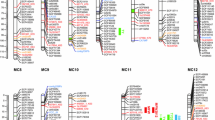Abstract
The large-fruited cranberry (Vaccinium macrocarpon Ait.) is a native North American fruit that is a rich source of dietary phytochemicals with demonstrated and potential benefits for human health. Cranberry is a perennial, self-fertile 2n = 2x = 24 diploid, with a haploid genome size of about 570 Mbp. Present commercial cultivars are only a few breeding and selection cycles removed from their wild progenitors. With an irreducible minimum of 2 years per generation, and significant space and time requirements for phenotypic selection of traits of horticultural interest, genetic enhancement of cranberry could be facilitated by marker-assisted selection (MAS); however, the necessary resources, such as transcript or genomic sequences, molecular genetic markers, and genetic linkage maps, are not yet available. We have begun to generate these resources, starting with next-generation [sequencing by oligonucleotide ligation and detection (SOLiD) mate-paired] sequencing of an inbred cranberry clone, assembling the reads, and developing microsatellite markers from the assembled sequence. Evaluation of the resulting cranberry genomic microsatellite primers has provided a test of the accuracy of the sequence assembly and supplied much-needed molecular markers for a genetic linkage map of cranberry. Mapping these markers will permit sequence scaffolds to be anchored on the genetic map.


Similar content being viewed by others
References
Angiosperm Phylogeny Group (2009) An update of the Angiosperm Phylogeny Group classification for the orders and families of flowering plants: APG III. Bot J Linn Soc 161:105–121
Bassil N, Oda A, Hummer KE (2009) Blueberry microsatellite markers identify cranberry cultivars. Acta Hortic 810:181–186
Bielenberg DG, Wang YE, Li Z, Zhebentyayeva T, Fan S, Reighard GL, Scorza R, Abbott AG (2008) Sequencing and annotation of the evergrowing locus in peach [Prunus persica (L.) Batsch] reveals a cluster of six MADS-box transcription factors as candidate genes for regulation of terminal bud formation. Tree Genet Genomes 4:495–507
Boches PS, Bassil NV, Rowland LJ (2005) Microsatellite markers for Vaccinium from EST and genomic libraries. Mol Ecol Notes 5:657–660
Costich DE, Ortiz R, Meagher TR, Bruederle LP, Vorsa N (1993) Determination of ploidy level and nuclear DNA content in blueberry by flow cytometry. Theor Appl Genet 86:1001–1006
Guay DRP (2009) Cranberry and urinary tract infections. Drugs 69:775–807
Johnson-Cicalese J, Vorsa N, Polashock J (2009) Breeding for fruit rot resistance in Vaccinium macrocarpon. Acta Hortic 810:191–198
Jung S, Staton M, Lee T, Blenda A, Svancara R, Abbott A, Main D (2008) GDR (Genome Database for Rosaceae): integrated web-database for Rosaceae genomics and genetics data. Nucleic Acids Res 36 (Database issue): D1034–D1040
Koo H, Duarte S, Murata RM, Scott-Anne K, Gregoire S, Watson GE, Singh AP, Vorsa N (2010) Influence of cranberry proanthocyanidins on formation of biofilms by Streptococcus mutans on saliva-coated apatitic surface and on dental caries development in vivo. Caries Res 44:116–126
Li R, Zhu H, Ruan J, Qian W, Fang X, Shi Z, Li Y, Li S, Gao S, Kristiansen K, Li S, Yang H, Wang J, Wang J (2010) De novo assembly of human genomes with massively parallel short read sequencing. Genome Res 20:265–272
Lutz KA, Wenqin W, Zdepski A, Michael TP (2011) Isolation and analysis of high quality nuclear DNA with reduced organellar DNA for plant genome sequencing and resequencing. BMC Biotechnol (accepted for publication)
Miller J, Koren S, Sutton G (2010) Assembly algorithms for next-generation sequencing data. Genomics 95:315–327
Morgante M, Olivieri AM (1993) PCR-amplified microsatellites as markers in plant genetics. Plant J 3:175–182
Neto CC, Amoroso JW, Liberty AM (2008) Anticancer activities of cranberry phytochemicals: an update. Mol Nutr Food Res 52:S18–S27
Oetting WS, Lee HK, Flanders DJ, Wiesner GL, Sellers TA, King RA (1995) Linkage analysis with multiplexed short tandem repeat polymorphisms using infrared fluorescence and M13 tailed primers. Genomics 30:450–458
Pappas E, Schaich KM (2009) Phytochemicals of cranberries and cranberry products: Characterization, potential health effects, and processing stability. Crit Rev Food Sci Nutr 49:741–781
Ruel G, Couillard C (2007) Evidences of the cardioprotective potential of fruits: the case of cranberries. Mol Nutr Food Res 51:692–701
Schuelke M (2000) An economic method for the fluorescent labeling of PCR fragments. Nat Biotechnol 18:233–234
Stewart CN, Via LE (1993) A rapid CTAB DNA isolation technique useful for RAPD fingerprinting and other PCR applications. BioTechniques 14:748–750
USDA NASS (2011) Noncitrus fruits and nuts 2010 Preliminary Summary. http://usda.mannlib.cornell.edu/usda/nass/NoncFruiNu//2010s/2011/NoncFruiNu-01-21-2011.pdf. Accessed 18 April 2011
Varshney RK, Graner A, Sorrells ME (2005) Genic microsatellite markers in plants: features and applications. Trends Biotechnol 23:48–55
Wu VCH, Qiu X, Bushway A, Harper L (2008) Antibacterial effects of American cranberry (Vaccinium macrocarpon) concentrate on foodborne pathogens. LWT-Food Sci Technol 41:1834–1841
Zerbino DR, Birney E (2008) Velvet: algorithms for de novo short read assembly using de Bruijn graphs. Genome Res 18:821–829
Acknowledgments
Funding for this work was provided by USDA SCRI grant number 2008-51180-04878, with additional funding from Ocean Spray Cranberries, Incorporated. We thank Dayani Stinson for technical support and Mark Diamond for assistance in manuscript preparation.
Author information
Authors and Affiliations
Corresponding author
Additional information
Persons wishing access to the cranberry sequence should contact the authors directly.
Rights and permissions
About this article
Cite this article
Georgi, L., Herai, R.H., Vidal, R. et al. Cranberry microsatellite marker development from assembled next-generation genomic sequence. Mol Breeding 30, 227–237 (2012). https://doi.org/10.1007/s11032-011-9613-7
Received:
Accepted:
Published:
Issue Date:
DOI: https://doi.org/10.1007/s11032-011-9613-7




